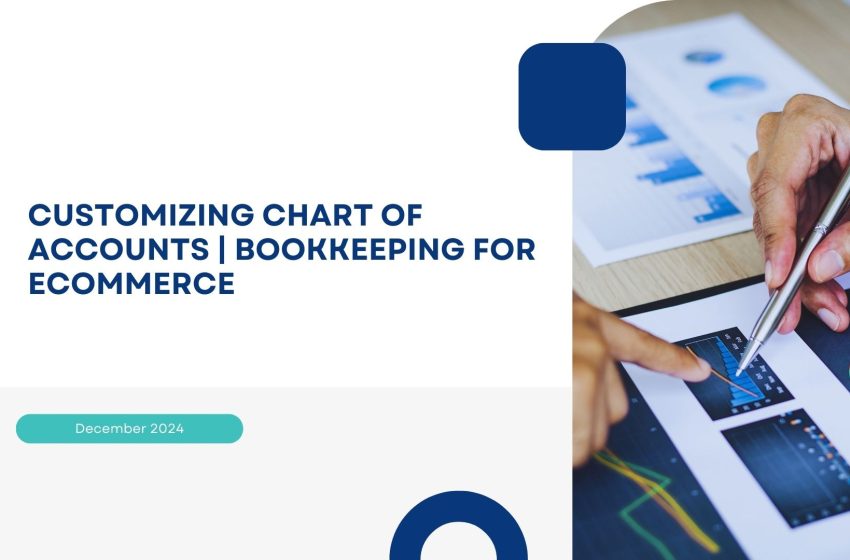Customizing Chart of Accounts | Bookkeeping for Ecommerce

Customizing Chart of Accounts for Ecommerce Businesses
A successful e-commerce company is built on sound financial management. Making and modifying a chart of accounts for e-commerce companies is a crucial part of financial organization. A properly designed chart of accounts (COA), adapted to the particular requirements of e-commerce, offers a thorough framework for monitoring revenue, expenses, assets, liabilities, and equity. Businesses can attain clarity, compliance, and success with the correct strategy, bolstered by contemporary online accounting tools and bookkeeping for e-commerce.
What Is a Chart of Accounts and Why Is It Important for Ecommerce?
A classified list of accounts used to document all financial activities is called a chart of accounts. As the foundation of an accounting system, it assists companies in tracking their financial performance and meeting legal and regulatory obligations. A generic COA for e-commerce companies sometimes overlooks the subtleties of online operations, like shipping costs, multi-platform revenue streams, and sales tax management.
Customizing your COA allows you to:
-
Gain clear insights into revenue and expense categories.
-
Streamline tax reporting and compliance.
-
Align financial data with specific ecommerce goals and metrics.
By leveraging online accounting platforms and focusing on bookkeeping for ecommerce, businesses can create a tailored COA that enhances decision-making and scalability.
Key Considerations When Customizing a Chart of Accounts for Ecommerce
1. Separate Revenue Streams
E-commerce companies frequently use several platforms, including Etsy, Shopify, and Amazon. Fees, commission schedules, and reporting requirements could vary from platform to platform. Accurate tracking of sales and associated costs is ensured by creating separate revenue accounts for each platform.
2. Track Cost of Goods Sold (COGS) Accurately
One important indicator for comprehending profitability is COGS. Making adjustments to account for product costs, manufacturing fees, and transportation guarantees accurate gross profit calculations. Inventory control and pricing methods benefit greatly from this data.
3. Sales Tax Compliance
States and nations have different sales tax laws, which makes compliance difficult. Establishing specific accounts for the collection and remittance of sales tax streamlines reporting and lowers the possibility of fines. Sales tax administration is immediately integrated into the bookkeeping process by a number of online accounting applications.
4. Expense Categorization
Marketing, platform fees, payment processing fees, and delivery costs are typical e-commerce expenses. By personalizing expense categories, you can keep an eye on spending patterns and spot areas where you might save costs.
5. Multi-Currency Transactions
For businesses selling internationally, multi-currency transactions are a common occurrence. Customized accounts for foreign currency gains and losses, along with dedicated accounts for international sales, help maintain accurate financial records.
Steps to Customize a Chart of Accounts for Ecommerce
Step 1: Understand Your Business Needs
Examine your e-commerce business’s particular transactions and processes. To decide which accounts you require, take into account variables such as tax jurisdictions, inventory systems, and platforms utilized.
Step 2: Choose an Online Accounting Platform
Platforms like QuickBooks Online, Xero, and FreshBooks are ideal for bookkeeping for ecommerce. They offer pre-built COA templates that can be customized to fit your business model.
Step 3: Create Detailed Account Categories
Structure your COA to include the following key sections:
-
Assets: Cash, inventory, accounts receivable, and prepaid expenses.
-
Liabilities: Accounts payable, sales tax payable, and loans.
-
Equity: Owner contributions and retained earnings.
-
Revenue: Separate accounts for each sales platform and other income streams.
-
Expenses: Marketing, platform fees, shipping, and payment processing.
Step 4: Regularly Review and Update
Ecommerce is a fast-changing industry. Periodically review your COA to ensure it reflects new revenue streams, expense categories, or regulatory requirements.
Step 5: Consult Experts
Working with a professional accountant experienced in bookkeeping for ecommerce ensures that your COA aligns with industry best practices and complies with tax laws.
Benefits of a Customized Chart of Accounts for Ecommerce
1. Improved Financial Clarity
A tailored COA offers a clear picture of where your money is coming from and where it’s going, helping you make informed decisions.
2. Streamlined Tax Reporting
Accurate categorization of income and expenses simplifies tax preparation, reducing the risk of errors and audits.
3. Enhanced Profitability Analysis
Tracking specific costs, such as marketing spend or shipping fees, helps identify areas where profitability can be improved.
4. Scalability
As your business grows, a customized COA evolves with it, accommodating new platforms, products, and markets.
5. Compliance Confidence
A well-structured COA ensures compliance with financial regulations, boosting trust with stakeholders and customers alike.
Leveraging Online Accounting for Chart of Accounts
Managing and personalizing your COA is easy with today’s online accounting systems. While improving accuracy, features like automation, e-commerce platform connectivity, and real-time reporting lessen the administrative load. For example:
-
Automation: Automatically categorize transactions based on predefined rules.
-
Integration: Sync sales data from platforms like Amazon and Shopify.
-
Insights: Generate detailed financial reports for strategic planning.
By combining the power of bookkeeping for ecommerce with advanced accounting tools, businesses can stay ahead in a competitive market.
Conclusion
Maintaining financial transparency and attaining long-term success for e-commerce enterprises requires customizing a chart of accounts. You can gain important insights and guarantee correct reporting by customizing your COA to handle particular e-commerce issues, such as multi-platform revenue, sales tax compliance, and COGS tracking. The procedure is made simpler by using online accounting tools and professional advice, enabling your company to grow profitably and compliantly.
FAQs
1. What is a chart of accounts in ecommerce bookkeeping?
A chart of accounts is a structured list of financial accounts used to record and categorize transactions, tailored to meet the specific needs of ecommerce businesses.
2. Why is customizing a chart of accounts important for ecommerce?
Customizing a COA ensures accurate tracking of income, expenses, and taxes, making it easier to manage multi-platform sales, inventory, and compliance.
3. How can online accounting tools help with COA customization?
Online accounting tools simplify COA customization by providing templates, automating transaction categorization, and integrating with ecommerce platforms.
4. What are the key accounts every ecommerce business should include?
Key accounts include platform-specific revenue accounts, cost of goods sold (COGS), sales tax payable, shipping costs, and marketing expenses.
5. Can I outsource chart of accounts customization for my ecommerce business?
Yes, outsourcing to a professional accountant or bookkeeping service ensures that your COA is tailored to your business needs and complies with financial regulations.

